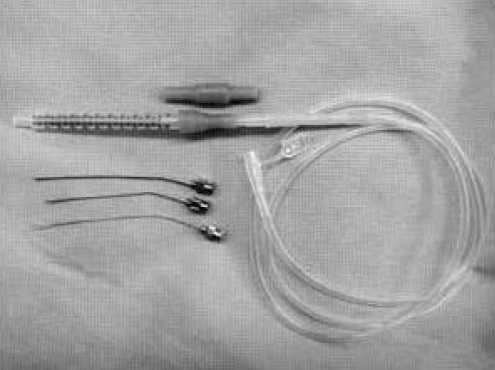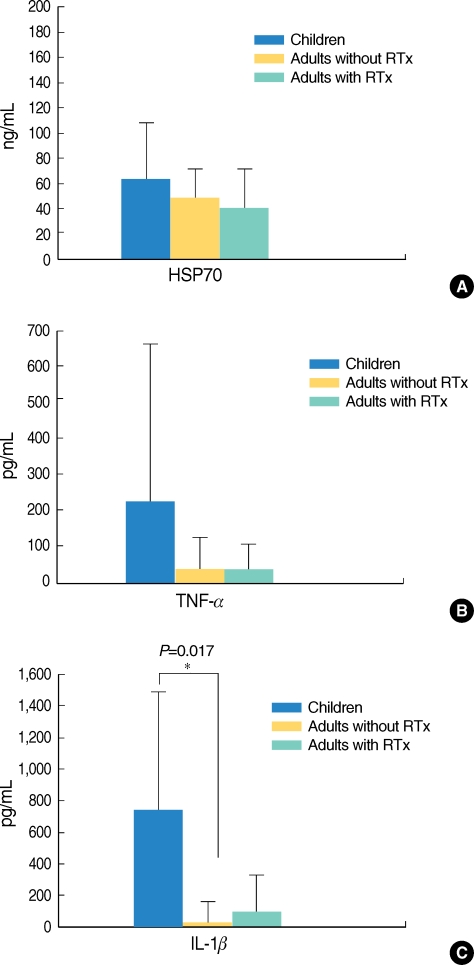Clin Exp Otorhinolaryngol.
2010 Mar;3(1):18-23.
Expression of HSP70 and Its Relation with Other Cytokines in Human Middle Ear Effusion
- Affiliations
-
- 1Department of Otorhinolaryngology-Head and Neck Surgery, The Catholic University of Korea School of Medicine, Seoul, Korea. swyeo@catholic.ac.kr
Abstract
OBJECTIVES
While other cytokines are known to be associated with otitis media with effusion (OME), the involvement of heat shock protein 70 (HSP70) in middle ear effusion (MEE) is unknown. This study was undertaken to investigate the possibility of there being a HSP70 expression in human MEE and to determine its potential role as a cytokine in OME.
METHODS
The levels of HSP70, tumor necrosis factor-alpha and interleukin-1beta were measured by enzyme-linked immunosorbent assay in the effusion of different groups of OME patient following collection of the MEE using our new collection system. The clinical characteristics of the OME patients and the MEE status were analyzed.
RESULTS
HSP70 was expressed in all the types of MEE. The mucous and seromucous effusions showed higher HSP70 levels than that of the serous effusion. The HSP70 level was correlated with the levels of tumor necrosis factor (TNF)-alpha and interleukin (IL)-1beta in the effusions. The positive correlations between HSP70, TNF-alpha and IL-1beta were statistically significant (P<0.05).
CONCLUSION
The highly elevated level of HSP70 in the seromucous and mucous effusions implicates this protein in the chronicity of OME.
MeSH Terms
Figure
Reference
-
1. Yellon RF, Doyle WJ, Whiteside TL, Diven WF, March AR, Fireman P. Cytokines, immunoglobulins, and bacterial pathogens in middle ear effusions. Arch Otolaryngol Head Neck Surg. 1995; 8. 121(8):865–869. PMID: 7619411.
Article2. Maxwell KS, Fitzgerald JE, Burleson JA, Leonard G, Carpenter R, Kreutzer DL. Interleukin-8 expression in otitis media. Laryngoscope. 1994; 8. 104(8 Pt 1):989–995. PMID: 8052085.
Article3. Narkio-Makela M, Teppo AM, Meri S. Complement C3 cleavage and cytokines interleukin-1beta and tumor necrosis factor-alpha in otitis media with effusion. Laryngoscope. 2000; 10. 110(10 Pt 1):1745–1749. PMID: 11037838.4. Jang CH, Kim YH. Characterization of cytokines present in pediatric otitis media with effusion: comparison of allergy positive and negative. Int J Pediatr Otorhinolaryngol. 2002; 10. 21. 66(1):37–40. PMID: 12363420.
Article5. Trautinger F. Heat shock proteins in the photobiology of human skin. J Photochem Photobiol B. 2001; 10. 63(1-3):70–77. PMID: 11684453.
Article6. Srivastava P. Roles of heat-shock proteins in innate and adaptive immunity. Nat Rev Immunol. 2002; 3. 2(3):185–194. PMID: 11913069.
Article7. Egusa K, Huang CC, Haddad J Jr. Heat shock proteins in acute otitis media. Laryngoscope. 1995; 7. 105(7 Pt 1):708–713. PMID: 7603274.
Article8. Bi AF, Zou J, Zhou YQ, Shang YD, Zhao QS. HSP70 expression of middle ear mucosa in acute suppurative otitis media. Lin Chuang Er Bi Yan Hou Ke Za Zhi. 2000; 4. 14(4):173–174. PMID: 12541495.9. Yeo M, Park HK, Kim DK, Cho SW, Kim YS, Cho SY, et al. Restoration of heat shock protein70 suppresses gastric mucosal inducible nitric oxide synthase expression induced by Helicobacter pylori. Proteomics. 2004; 11. 4(11):3335–3342. PMID: 15378740.10. Yusuf N, Nasti TH, Huang CM, Huber BS, Jaleel T, Lin HY, et al. Heat shock proteins HSP27 and HSP70 are present in the skin and are important mediators of allergic contact hypersensitivity. J Immunol. 2009; 1. 01. 182(1):675–683. PMID: 19109201.
Article11. Morton RP, Woollons AC, McIvor NP. Nasopharyngeal carcinoma and middle ear effusion: natural history and the effect of ventilation tubes. Clin Otolaryngol Allied Sci. 1994; 12. 19(6):529–531. PMID: 7895386.
Article12. Ondrey FG, Juhn SK, Adams GL. Early-response cytokine expression in adult middle ear effusions. Otolaryngol Head Neck Surg. 1998; 10. 119(4):342–345. PMID: 9781987.
Article13. Takayama S, Reed JC, Homma S. Heat-shock proteins as regulators of apoptosis. Oncogene. 2003; 12. 08. 22(56):9041–9047. PMID: 14663482.
Article14. Hartl FU, Hayer-Hartl M. Molecular chaperones in the cytosol: from nascent chain to folded protein. Science. 2002; 3. 08. 295(5561):1852–1858. PMID: 11884745.
Article15. Nakamura K, Rokutan K, Marui N, Aoike A, Kawai K. Induction of heat shock proteins and their implication in protection against ethanol-induced damage in cultured guinea pig gastric mucosal cells. Gastroenterology. 1991; 7. 101(1):161–166. PMID: 2044905.
Article16. Wong HR, Finder JD, Wasserloos K, Pitt BR. Expression of iNOS in cultured rat pulmonary artery smooth muscle cells is inhibited by the heat shock response. Am J Physiol. 1995; 12. 269(6 Pt 1):L843–L848. PMID: 8572246.
Article17. Hauser GJ, Dayao EK, Wasserloos K, Pitt BR, Wong HR. HSP induction inhibits iNOS mRNA expression and attenuates hypotension in endotoxin-challenged rats. Am J Physiol. 1996; 12. 271(6 Pt 2):H2529–H2535. PMID: 8997314.
Article18. Kang JM, Yeo SW, Chang KH, Suh BD. Expression of inducible nitric oxide synthase in the experimental otitis media with effusion. Korean J Otolaryngol - Head Neck Surg. 1999; 12. 42(12):1483–1489.19. Li W, Lin J, Adams GL, Juhn SK. Expression of inducible nitric oxide synthase (iNOS) in middle ear epithelial cells by IL-1beta and TNF-alpha. Int J Pediatr Otorhinolaryngol. 2000; 9. 19. 55(2):91–98. PMID: 11006448.20. Nell MJ, Grote JJ. Endotoxin and tumor necrosis factor-alpha in middle ear effusions in relation to upper airway infection. Laryngoscope. 1999; 11. 109(11):1815–1819. PMID: 10569413.
- Full Text Links
- Actions
-
Cited
- CITED
-
- Close
- Share
- Similar articles
-
- Relations between the concentrations of IL-1beta and TNF-alpha and clinical features in middle ear effusion
- Studies on Relationships between Inflammatory Cell, Cytokines and Clinical Features in Pediatric Otitis Media with Effusion
- Profile of arachidonic acid metabolites and platelet-activatingfactors in human middle ear effusion
- Differential expression of two stress-inducible hsp70 genes by various stressors
- Diagnosis of Middle Ear Effusion in Neonate and Infant: Pitfalls of Conventional Impedance Audiometry Using 226 Hz Probe Tone



